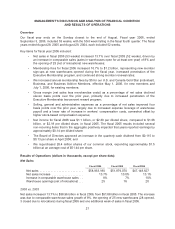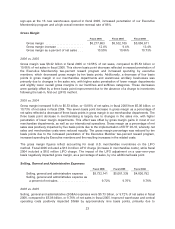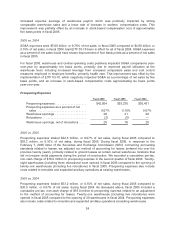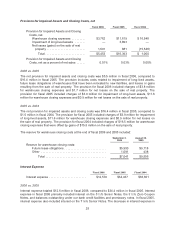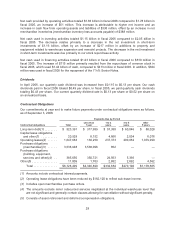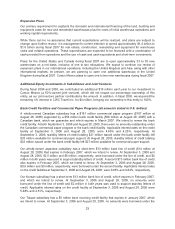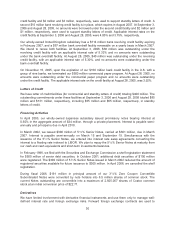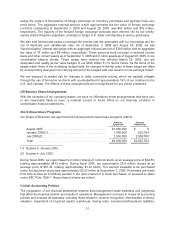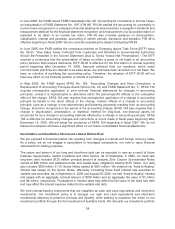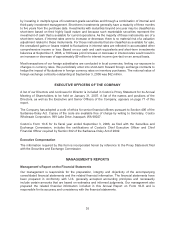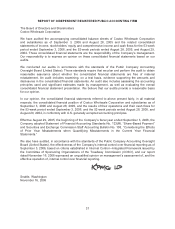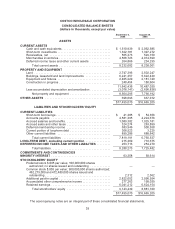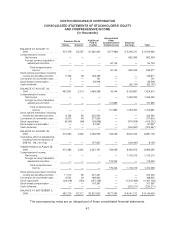Costco 2006 Annual Report Download - page 33
Download and view the complete annual report
Please find page 33 of the 2006 Costco annual report below. You can navigate through the pages in the report by either clicking on the pages listed below, or by using the keyword search tool below to find specific information within the annual report.
hedge the impact of fluctuations of foreign exchange on inventory purchases and typically have very
short terms. The aggregate notional amount, which approximates the fair value of foreign exchange
contracts outstanding at September 3, 2006 and August 28, 2005, was $63 million and $42 million,
respectively. The majority of the forward foreign exchange contracts were entered into by our wholly-
owned United Kingdom subsidiary, primarily to hedge U.S. dollar merchandise inventory purchases.
We also hold interest rate swaps to manage the interest rate risk associated with our borrowings and the
mix of fixed-rate and variable-rate debt. As of September 3, 2006 and August 28, 2005, we had
“fixed-to-floating” interest rate swaps with an aggregate notional amount of $300 million and an aggregate
fair value of $1 million and $8 million, respectively. These amounts were recorded in deferred income
taxes and other current assets as of September 3, 2006 and in other assets as of August 28, 2005, in our
consolidated balance sheets. These swaps were entered into effective March 25, 2002, and are
designated and qualify as fair value hedges of our $300 million 5
1
⁄
2
% Senior Notes. As the terms of the
swaps match those of the underlying hedged debt, the changes in the fair value of these swaps are offset
by corresponding changes in the carrying amount of the hedged debt and result in no net earnings impact.
We are exposed to market risk for changes in utility commodity pricing, which we partially mitigate
through the use of firm-price contracts with counterparties for approximately 19% of our locations in the
U.S. and Canada. The effects of these arrangements are not significant for any period presented.
Off-Balance Sheet Arrangements
With the exception of our operating leases, we have no off-balance sheet arrangements that have had,
or are reasonably likely to have, a material current or future effect on our financial condition or
consolidated financial statements.
Stock Repurchase Programs
Our Board of Directors has approved the following stock repurchase programs (000’s):
Amount
Approved Amount
Remaining
August 2005 ....................................... $1,000,000 $ 0
January 2006(1) .................................... 1,000,000 625,534
July 2006(2) ....................................... 2,000,000 2,000,000
Total .............................................. $4,000,000 $2,625,534
(1) Expires in January 2009.
(2) Expires in July 2009.
During fiscal 2005, we repurchased 9.2 million shares of common stock, at an average price of $44.89,
totaling approximately $413 million. During fiscal 2006, we repurchased 28.4 million shares at an
average price of $51.44, totaling approximately $1.46 billion. The amount available to be purchased
under the approved plans was approximately $2.63 billion at September 3, 2006. Purchases are made
from time-to-time as conditions warrant in the open market or in block purchases, or pursuant to plans
under SEC Rule 10b5-1. Repurchased shares are retired.
Critical Accounting Policies
The preparation of our financial statements requires that management make estimates and judgments
that affect the financial position and results of operations. Management continues to review its accounting
policies and evaluate its estimates, including those related to revenue recognition, merchandise inventory
valuation, impairment of long-lived assets, warehouse closing costs, insurance/self-insurance liabilities,
31


